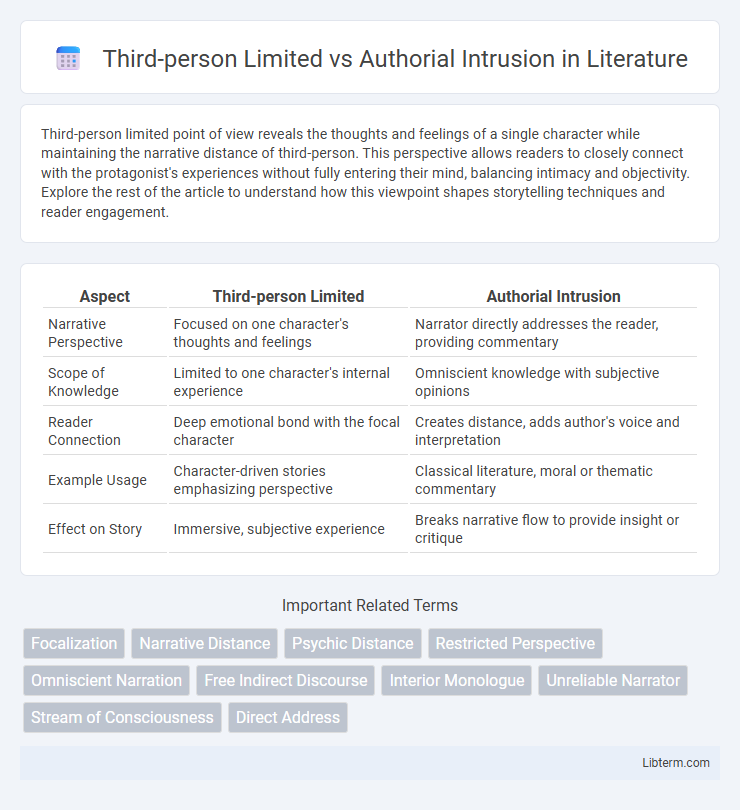Third-person limited point of view reveals the thoughts and feelings of a single character while maintaining the narrative distance of third-person. This perspective allows readers to closely connect with the protagonist's experiences without fully entering their mind, balancing intimacy and objectivity. Explore the rest of the article to understand how this viewpoint shapes storytelling techniques and reader engagement.
Table of Comparison
| Aspect | Third-person Limited | Authorial Intrusion |
|---|---|---|
| Narrative Perspective | Focused on one character's thoughts and feelings | Narrator directly addresses the reader, providing commentary |
| Scope of Knowledge | Limited to one character's internal experience | Omniscient knowledge with subjective opinions |
| Reader Connection | Deep emotional bond with the focal character | Creates distance, adds author's voice and interpretation |
| Example Usage | Character-driven stories emphasizing perspective | Classical literature, moral or thematic commentary |
| Effect on Story | Immersive, subjective experience | Breaks narrative flow to provide insight or critique |
Understanding Third-person Limited Narration
Third-person limited narration offers a focused perspective, revealing the thoughts and feelings of a single character while maintaining an external viewpoint. This narrative style contrasts with authorial intrusion, where the narrator directly addresses the reader or injects commentary outside the characters' experiences. Understanding third-person limited helps writers create intimate character development without breaking narrative immersion.
Defining Authorial Intrusion
Authorial intrusion occurs when the narrator directly addresses the reader or offers personal commentary, breaking the story's immersive experience. In contrast, third-person limited narration confines the perspective to a single character's thoughts and feelings without overt commentary from the author. Defining authorial intrusion involves recognizing moments where the narrator steps outside the narrative voice to insert opinions or explanations that disrupt the story's natural flow.
Key Differences Between Third-person Limited and Authorial Intrusion
Third-person limited narration confines the story to one character's perspective, revealing only their thoughts and feelings while maintaining the story's immersive experience. Authorial intrusion breaks the narrative flow by the narrator directly addressing the reader or offering unsolicited commentary, often shifting away from character perspectives. The key difference lies in the narrative control--third-person limited stays within a single character's viewpoint, whereas authorial intrusion introduces the author's voice distinct from the characters.
Narrative Focus and Perspective
Third-person limited narration restricts the narrative focus to a single character's thoughts and experiences, providing intimate insight while maintaining an external viewpoint. Authorial intrusion breaks this narrative focus by directly addressing the reader or offering the author's commentary, shifting the perspective from the story world to an external voice. This intrusion disrupts the immersive experience by blending the character's viewpoint with the author's, altering the narrative's consistency and control.
Impact on Reader Engagement
Third-person limited narration fosters deep reader engagement by closely aligning the narrative with a single character's thoughts and emotions, creating intimate and immersive experiences. Authorial intrusion breaks the narrative flow by inserting the author's voice or commentary, which can disrupt immersion but also provide critical insights or humor that reengage the reader in distinct ways. The strategic use of authorial intrusion may challenge readers to think more critically, while third-person limited typically enhances emotional connection.
Managing Character Insight and Knowledge
Third-person limited perspective restricts the narrative to the thoughts and knowledge of a single character, enabling a deep, intimate understanding of their motivations and perceptions while maintaining suspense about other characters' inner lives. Authorial intrusion breaks this boundary by allowing the narrator to provide information, commentary, or insights beyond the character's awareness, offering a broader or more objective view that can guide reader interpretation. Balancing these techniques involves carefully managing the flow of character insight to maintain narrative focus and control over how much knowledge is revealed to the audience versus what remains concealed.
Examples of Third-person Limited in Literature
Third-person limited narration offers a deep dive into a single character's thoughts and feelings, as exemplified in Harper Lee's *To Kill a Mockingbird*, where Scout Finch's perspective shapes the narrative. In J.K. Rowling's *Harry Potter* series, the third-person limited viewpoint closely follows Harry's experiences and emotions, enhancing reader connection. This approach contrasts with authorial intrusion, where the narrator frequently steps outside the story to provide commentary, seen in works like Jane Austen's *Emma*.
Notable Instances of Authorial Intrusion
Notable instances of authorial intrusion appear in classic literature such as Jane Austen's "Emma," where the narrator directly addresses the reader to provide commentary or moral insight, breaking the narrative flow. Unlike third-person limited perspective, which confines the viewpoint to a single character's thoughts and experiences, authorial intrusion overtly reveals the author's presence, guiding interpretation and emphasizing thematic elements. This technique challenges the illusion of an objective narrative voice, creating a distinctive interaction between author, text, and reader.
Choosing the Right Technique for Your Story
Choosing between third-person limited and authorial intrusion depends on the desired narrative intimacy and control. Third-person limited offers deep insight into a single character's thoughts and emotions, creating a focused and immersive experience. Authorial intrusion breaks the narrative flow to provide commentary or context, shaping reader interpretation while maintaining a more distant storytelling voice.
Balancing Objectivity and Authorial Voice
Third-person limited narration maintains objectivity by closely aligning the narrative voice with a single character's perspective, allowing readers to experience events and emotions without overt authorial commentary. Authorial intrusion breaks this narrative boundary by inserting the author's voice directly, often providing explicit opinions or context that transcends the character's viewpoint. Effective storytelling balances these techniques by using third-person limited to build immersive character depth while deploying subtle authorial reflections to guide interpretation without disrupting narrative immersion.
Third-person Limited Infographic

 libterm.com
libterm.com